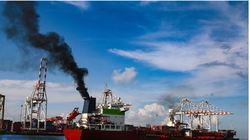Green shipping push to lift pandemic-hit shipbuilding orders

The coronavirus-led economic slowdown has forced a review of newbuild plans, but shipbuilders may receive a fillip from the global drive to cut emissions as shipowners look for the best options in the future.
Lloyd’s Register says deepsea zero-emission vessels need to enter the fleet by 2030 to meet the IMO’s 2050 decarbonisation goals. As such, shipowners obliged to meet these targets are expected to make decisions on either retrofitting existing tonnage or building new vessels to run on fuels complying with IMO 2050 decarbonisation goals in the next five years
The race to decarbonise international shipping should give shipbuilders some cheer as shipowners are obliged to retrofit or build ships with zero-emission profiles.
THE coronavirus pandemic has triggered a drastic slowdown in shipbuilding activity and set back plans for dual-fuel newbuilds with smaller environmental footprints.
While noting this fact and forecasting fewer additions to the global fleet post-pandemic, two experts with classification society Lloyd’s Register argued however, that these would not hold back the technology enabling ships to run on carbon-neutral fuels from maturing as early as five years down the road.
Newbuild orders across all vessel types numbered just 331 as of August 14, far off from the full-year tally of 1,160 for 2019, data from ship brokerage Clarksons showed.
“Shipowners have refrained from ordering new vessels as a result of the economic downturn and market uncertainty caused by the pandemic,” Mike Holiday, regional manager for marine and offshore for South Asia, the Middle East and Africa at Lloyd’s Register said.
Further undermining the backdrop around shipbuilding was a drastic decline in prices of conventional bunker fuels, which “makes it slightly more challenging” for shipowners to make calls on dual-fuel newbuilds, he added.
Prices of 0.5% sulphur fuel oil, or very-low sulphur fuel oil, which complies with the International Maritime Organization’s global sulphur cap, are seen hovering at around half of January’s peak based on trades done in Singapore, the world’s top bunkering hub by marine fuel sales.
Shipowners, once banking on potential cost savings by choosing newbuilds equipped to burn conventional oil-based fuels as well as a cleaner-burning alternative at the same time, now need to rework their business cases.
This inevitably slows down plans for fleet building or renewal to meet tightening and evolving emissions rules.
The IMO has outlined ambitious goals about decarbonisation and overall greenhouse gas emissions relating to international shipping.
It aims to reduce carbon intensity by 40% come 2030 and halve greenhouse gas emissions by 2050.
Shipowners would have to hedge their bets when ordering newbuilds years ahead of these regulatory targets by picking newbuilds with dual fuel engines.
Liquefied natural gas, touted by some as capable of meeting stricter GHG emissions regulations through to 2030, often emerges as one alternative fuel under consideration for such newbuilds.
Mr Holiday cited the maturity of LNG bunkering technology as supporting interest in LNG dual-fuel vessels.
But the active global fleet today is still mostly run on VLSFO, implying there remains much room for investment in newbuilds or retrofits, whether for adopting LNG or other alternatives.
What is more, Lloyd’s Register holds the view that deepsea zero-emission vessels need to enter the fleet by 2030 to meet the IMO’s 2050 goals.
Cargo ships built to run on methanol and LNG have already hit the water. These fuels are not carbon neutral because they are now mainly derived from fossil sources.
Shipping players including Maersk have embarked on cross-industry research on the next generation methanol and LNG to be extracted from biomass or combining sequestered carbon with hydrogen.
To this end, shipowners betting on methanol- and LNG-fuelled newbuilds to transition to 2050, may draw some comfort from one expert opinion.
LR Global FOBAS manager Douglas Raitt holds the view that “material changes” to the technology of ship engines are not expected even as these two fuels pivot to bio-methanol or bio-LNG.
He also flagged possible progress for marine applications of ammonia, projecting that ammonia-fueling technology would be proven by the mid-2020s.
Ammonia and hydrogen are two other possible future fuels touted as enabling zero-emission shipping.